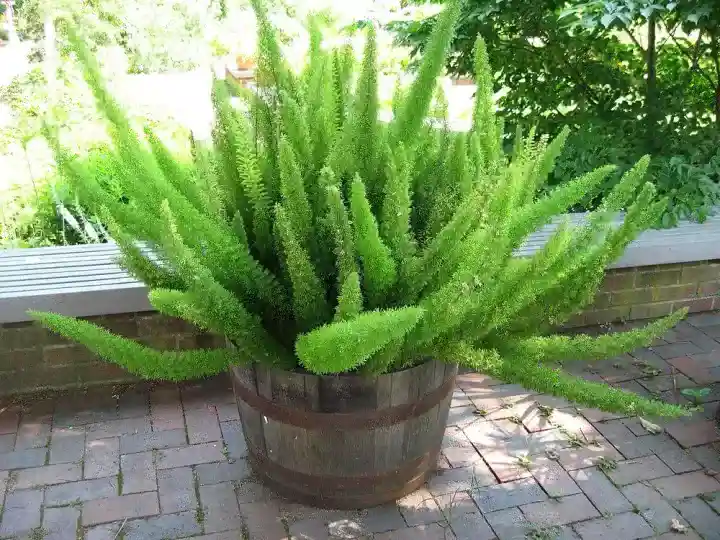Welcome to your guide on caring for the common asparagus fern, also known as Asparagus densiflorus. This popular houseplant is loved for its delicate foliage and ease of care. Whether you’re a seasoned plant enthusiast or a beginner, the common asparagus fern is a great addition to any indoor or outdoor space. In this section, we’ll provide an overview of the plant and its care requirements, so you can cultivate a thriving asparagus fern of your own.
Growing the Common Asparagus Fern Indoors
As a popular houseplant, the common asparagus fern is relatively easy to grow indoors. It prefers bright, indirect light and temperatures between 60-70°F (15-21°C).
When it comes to soil, the asparagus fern needs a well-draining mix that retains moisture. A combination of peat moss and perlite or vermiculite is ideal. Keep the soil moist, but avoid over-watering as this can lead to root rot.
If you notice yellowing leaves or drooping stems, it may be a sign of underwatering. In contrast, over-watering can cause the leaves to turn brown or black. Strike a balance and try not to let the soil dry out completely between waterings.
One potential issue with growing asparagus ferns indoors is their susceptibility to spider mites and mealybugs. Keep an eye out for these pests and treat them promptly with insecticidal soap or neem oil.
To promote healthy growth, fertilize the plant every two to three weeks during the growing season with a balanced, water-soluble fertilizer.
Growing the Common Asparagus Fern Indoors Tips
- Place the plant near a window that faces east or west to receive bright, indirect light.
- Mist the leaves occasionally to provide additional humidity.
- Rotate the pot once a week to ensure even growth.

Types of Common Asparagus Ferns
The common asparagus fern, Asparagus densiflorus, comes in several different varieties that plant enthusiasts can choose from to add a unique touch to their indoor or outdoor garden. Let’s take a closer look at some of the most popular types:
| Variety | Description |
|---|---|
| Asparagus Densiflorous Myers | A compact, bushy plant with small, needle-like leaves that appear in whorls. It is an excellent choice for indoor cultivation, requiring minimal space or care. |
| Asparagus Densiflorous Sprengeri | A trailing plant with delicate, feathery foliage that cascades from hanging baskets or containers. It is a popular choice for indoor or outdoor decoration due to its graceful appearance. |
| Asparagus Densiflorous Plumosus
| A dense, mounding plant with fern-like leaves that can be shaped into various forms, such as topiaries or wreaths. It is often used in floral arrangements and adds an elegant touch to any room. |
While these are some of the most common types of asparagus ferns, other varieties, such as the Foxtail Fern and the Ming Fern, are also popular among gardeners. No matter which type you choose, make sure to research its specific care requirements to ensure optimal growth and health.
Propagating the Common Asparagus Fern
Propagating the common asparagus fern is a simple process that can be achieved through division, stem cuttings, or spore propagation. Each method has its nuances, and the degree of success may vary depending on environmental factors and the health of the parent plant.
Division:
Division involves separating the parent plant into several smaller ones, each with its own roots and foliage. To do this, carefully lift the parent plant from its container and gently separate the root ball into several sections using a sharp knife or pruning shears. Ensure that each new section has enough roots and foliage to support its growth. Repot each section in a suitable container or in the ground, water well, and allow it to acclimate to its new environment.
Stem cuttings:
Propagating asparagus fern through stem cuttings involves taking a 4-6 inch long cutting from the parent plant’s stem and planting it in well-draining soil. Before planting, remove the lower leaves and dip the cutting in rooting hormone to promote root growth. Place the cutting in a bright location that receives indirect sunlight and keep the soil consistently moist. Once roots have developed, transplant the new plant into its permanent container or location.
Spore propagation:
Propagating the common asparagus fern through spores requires patience and attention to detail. Spores are located on the underside of mature fronds and resemble small brown dots. To collect the spores, place a mature frond inside a sealed plastic bag, and wait for the spores to fall. Once collected, sprinkle the spores on top of well-draining soil and mist it lightly with water. Cover the container with plastic wrap to maintain humidity and place it in a bright location out of direct sunlight. Keep the soil moist and wait for the spores to germinate and develop into young plants, which can be transplanted into their permanent locations once they have reached adequate size.
Pruning and Maintenance of the Common Asparagus Fern
Regular pruning and maintenance are crucial for the optimal growth and appearance of the common asparagus fern. Here are some tips to keep your plant healthy:
- Prune as needed: Prune the fern to control its size and shape. Use a sharp, clean pair of scissors or pruning shears to remove any dead or damaged fronds. Be careful not to damage the healthy stems and foliage.
- Remove spent fronds: Remove any spent or yellowed fronds regularly to promote new growth. Cut the fronds as close to the base as possible without damaging the plant.
- Provide proper watering: Water the plant regularly, but avoid overwatering. The soil should be damp but not waterlogged. Allow the top inch of soil to dry out before watering again.
- Fertilize occasionally: The asparagus fern benefits from occasional fertilization during the growing season. Use a water-soluble fertilizer diluted to half strength every month or two.
- Clean the foliage: Dust the foliage with a damp cloth or spray it with water to keep the leaves clean and healthy. This helps prevent pests and diseases from taking hold.
- Watch for pests and diseases: Monitor your plant regularly for signs of pests and diseases, such as spider mites, scale, or root rot. Treat any issues promptly to prevent them from spreading.
“By following these simple guidelines, your common asparagus fern will thrive and add beauty to your indoor or outdoor space.”
Growing the Common Asparagus Fern Outdoors
While commonly grown as a houseplant, the common asparagus fern can also thrive outdoors in the right conditions.
When deciding to grow your asparagus fern outdoors, it’s important to consider your climate zone. The common asparagus fern thrives in USDA zones 9 through 11 and can survive in zone 8 with proper protection.
When planting outdoors, choose a location with partial to full shade and well-draining soil. The soil should be rich in organic matter, and the plant should be watered regularly, especially during periods of drought.
The common asparagus fern is a hardy plant, but it can be susceptible to pests and diseases. Protect it from pests, such as mealybugs and spider mites, by spraying it with insecticidal soap regularly.
Pruning is essential when growing the common asparagus fern outdoors to keep its growth and appearance in check. Regular pruning will help maintain its shape and prevent it from becoming unruly.
Consider planting the common asparagus fern in containers if you live in an area with extreme weather conditions. This way, you can move it indoors during harsh weather, such as frost, and protect it from damage.
The common asparagus fern can make an excellent addition to an outdoor garden display. Consider pairing it with other shade-loving plants, such as hostas, impatiens, and coleus, for a beautiful and vibrant garden.
Conclusion and Final Thoughts on Common Asparagus Fern Care
The Common Asparagus Fern, also known as Asparagus densiflorus, is a popular houseplant due to its attractive appearance and easy care requirements. As discussed throughout this article, proper care involves providing adequate light, maintaining the right temperature and moisture levels, and regular maintenance.
By following the guidelines outlined in this guide, plant enthusiasts can successfully cultivate and enjoy the Common Asparagus Fern in both indoor and outdoor settings. Remember to choose the right type of fern depending on your preferences and needs, and to propagate and prune as required to enhance the plant’s health and appearance.
As with any plant, there may be some challenges, but with patience and attention, even the novice gardener can develop a green thumb and keep their Common Asparagus Fern thriving. We hope this guide has provided valuable insights and practical tips for incorporating this stunning plant into your home or garden collection. Happy planting!













Comments are closed.